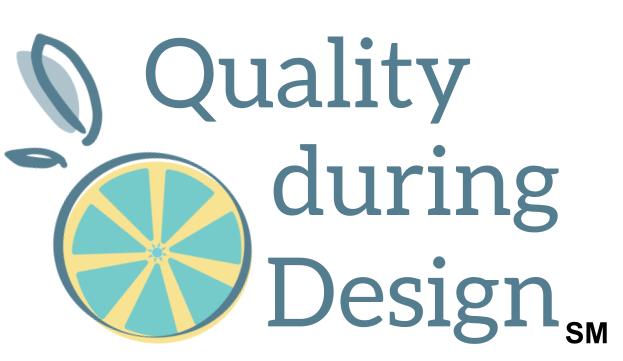Hi, welcome to quality during design for products, others love for less. I'm your host, Diana Deeney. Today, we're comparing a couple of topics between design and manufacturing, specifically design specifications versus manufacturing process control and capability. Now, really the kind of concepts that we're covering today have a lot to do with Design for Manufacturability. The choices made at design affects the downstream operations in manufacturing, and that's an important thing to consider when defining specifications for products. We'll be talking about process control versus process capability, and also where statistical process control fits and how it's related to design controls for risk. Design specifications, process control, and process capability all intersect and at the middle of where these intersect is where we have a process that is consistently creating products within specification.
To understand how this all ties together, we first need to recognize that there's variation everywhere in everything. Whenever we're measuring or counting something there's going to be variation. Variation is introduced just from the natural manufacturing process itself. It's introduced from the variation that's coming into the process from its raw materials and how it's handled. And there's even variation that is caused by the way we measure it. Our process outputs aren't single point outputs - they cover a range.
Just a couple of episodes ago in this "Versus" series, we compared discrete data versus continuous data: the two different types of data that we can get when we measure something. Discrete are counts or categories and continuous is measured on a continuous scale. When we plot our discrete data on a bar chart, we can look at its probability function as a probability mass function. If we have continuous data, we can plot it on a histogram and look at its probability density functions. These probability functions usually take on the classic bell-shaped curve, or at least we hope they do because that means it's normally distributed and makes statistical analysis a lot easier. But there are other probability distributions we could use. The point is: these probability functions represent the range of the process and manufacturing process outputs that we could be looking at, or considering, when we're setting design specifications.
Now let's consider and talk about how a process may develop over time. Design engineers may set a lower and an upper spec limit, but then the variation of the process itself needs to be evaluated. Say, it's a brand new process that we're not that familiar with and don't fully understand. We'll likely start out with a process that's out of control. The peak of our bell shaped curve is going to shift from left to right. And it depends on the process inputs that we don't fully understand and aren't controlling. We cannot use a probability function to adequately describe how process is going to react in the future. And we can't use it to predict how much of our product is really out of specification. Our process is all over the place.
As we learn more about our manufacturing process, we start to be able to repeat and reproduce the results and the outputs that we want. This is when we can get a process that is in control. We can use probability functions to estimate how much or what percentage of our product is out of specification. The peak of our bell-shaped curve is no longer shifting from left to right - it's consistent. Our process is now in control, but it's may not be capable, meaning that it's producing product that is beyond the spec limits that were set by the design. And whether or not our process is control is dependent on the design feature that we're measuring. It could be in control for the outer diameter, but the inner diameter is not in control.
Finally, as we hone and develop our manufacturing processes, even more, we can get to a point where our process is both in control and capable. The peak of our bell shaped curve now is no longer shifting and we're manufacturing product that is within a lower and upper spec limits of the design tolerances.
This highlights the difference between a process that's in control and a process that's capable.
When we're setting design specifications. We're thinking about tolerances and limits and definitions about the things that affect our design, our design's functionality, its performance, and its safety. For that reason, we sometimes call design specifications the "voice of the customer" because they relate back to how our customer is using the product and how the product gets used in the field, if it's functional and performing as we intended. So, design specifications are "voice of the customer". Our process, on the other hand, can produce a range of values of process outputs. And the features that we measure are defined as part of the design spec. Design specs are defining the "voice of the customer", it's also setting what features is most likely to be inspected and monitored during manufacturing processing. But the process is the process - there's going to be variation. And for that reason, sometimes the natural variation of a manufacturing process is called the "voice of the process". Process capability is the comparison between these two things: between the "voice of customer" and the "voice of the process".
How manufacturing process development fits into design specifications is like this. We first define features to measure and their limits based on risk, either risk of not working functionally or not performing as expected or to desired and also safety and environmental risks. Then we assess if the manufacturing process is in control or stable. If it is in control and stable, then we can assess the process capability: is it able to produce parts consistently within spec? So as designers, the design specifications are defining the design features to measure for both process control and process capability. But the design specifications are really only considered when we're evaluating the process capability.
Now what's affecting the spread of our process and the range of different process outputs that we could be getting are special causes and common causes. Common causes are those things that we would expect to vary in our process from day to day: slight variations in the raw materials, or maybe the temperature and humidity changes in the building. These could be common causes that could affect the variability of our process output. The other cause is a special cause. And those are causes that are unusual and not expected. And those are the kind of causes that we really want to just get rid of. And special causes are the things that we want to monitor with statistical process control tools. Statistical process control usually uses control charts that use statistical methods to identify if there are a special cause of variation that needs to be corrected. Special causes could be wear on equipment or tooling or a new lot of material. Control charts provide evidence that the process is still in control. SPC isn't typically related to design specifications. It's showing that a process is stable over time. Remember that we first make sure the process is stable. And then we can determine if it's capable of meeting the specs.
What's today's insight to action?
Well, first recognize that there's variation in everything, and we can use statistical methods to analyze and monitor the effects of that variability on the output of our manufacturing process.
We want to define design limits for our parts, considering typical process capabilities. For example, if we set a .001" tolerance on a plastic injection molded part that could be problematic. It could be more difficult to make (and it actually may be impossible to make, depending on the part), the tooling would have to be more precise, there would be more monitoring, more scrap, and all of that leads to a higher cost of product. It's something that we want to avoid. Now, if we're not sure about the realistic process capabilities related to whatever we're designing, then we can talk to somebody that's in the manufacturing department: a process engineer or a quality engineer, and they can help determine what's a realistic tolerance that could be, or may be, maintained for the type of part that you're designing.
We also need to consider the manufacturing and technology limitations when designing. Just because it exists doesn't mean that we have access to it to be able to use it.
if you work in a place with manufacturing or have a relationship with a trusted supplier that manufactures components for you, find out if they do statistical process control and get familiar with process variation and manufacturing, it will help you design for manufacturing. And it'll also help you design for your customers, both internal and external.



